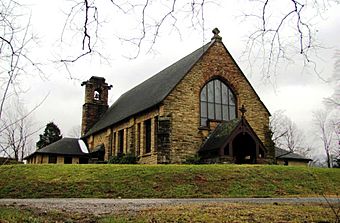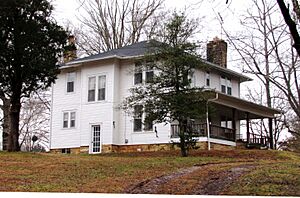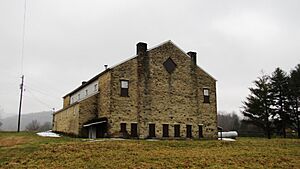Alpine Institute facts for kids
Quick facts for kids |
|
|
Alpine Institute
|
|

Christ Church Presbyterian at the old Alpine Institute campus
|
|
| Location | State Route 52 |
|---|---|
| Nearest city | Alpine, Tennessee |
| Area | 25 acres (10 ha) |
| Built | 1920 |
| Architectural style | Gothic Revival |
| NRHP reference No. | 02001339 |
| Added to NRHP | November 15, 2002 |
The Alpine Institute was a special school in Overton County, Tennessee. It was run by the Presbyterian church. The school taught children in a quiet, hilly part of Tennessee. It operated from 1821 until 1947. In 2002, some of the old school buildings were added to the National Register of Historic Places. This means they are important historical sites.
A minister named John Dillard started the Alpine School in 1821. It was located on Alpine Mountain. The school grew bigger in the 1840s. During the Civil War, the school was burned down. A group called the Ku Klux Klan burned it again after the war.
The school was rebuilt in 1880 at the bottom of Alpine Mountain. Albert H. Roberts, who later became Tennessee's governor, led the school. It became very successful. In 1917, the Presbyterian Church (U.S.A.) took over. They helped the Alpine Institute become one of the best rural schools in the state.
Contents
Where Was Alpine Institute?
The Alpine Institute was located in the Alpine community. This is along Highway 52, also known as Jamestown Highway. It's about 10 miles (16 km) east of Livingston. The community sits in a valley. Nettlecarrier Creek flows through this valley. High ridges surround the area. Alpine Mountain, which is 1,826-foot (557 m) tall, rises to the south.
A small road called Campus Circle leads to the church and other buildings. The school also had a farm. You can reach the farm from Mountain Lane and Pat Carr Lane.
History of the Alpine Institute
How It Started (Early Years)
John Dillard, a minister from Virginia, helped start the Cumberland Presbyterian Church. He is often given credit for starting "Alpine Academy" in 1821. Some people think his partner, Christopher Organ, started a school even earlier. Others believe both men started schools that later joined together. By the 1840s, Dillard and Organ worked together. They had built a fairly large school campus on Alpine Mountain. John Dillard's son, William, taught there. John Beveridge, who later became governor of Illinois, also taught at the school.
During the Civil War, there was a lot of disorder in the area. The Alpine school was destroyed by groups causing trouble. The school tried to rebuild after the war. However, a violent group called the Ku Klux Klan burned what was left of the campus. By 1866, Dillard had left Tennessee. Plans to rebuild the school were stopped for a while.
The Davis and Roberts Era (1880s and 1890s)
In 1880, Alpine Academy was reopened. It was built at its current spot, at the base of Alpine Mountain. The school first had five teachers. They used new ways of teaching. The first school catalog showed 94 boys and 48 girls enrolled. W. T. Davis was the principal, and the school continued to grow.
In 1891, Albert H. Roberts (1868–1946) became the principal. He was from Alpine and later became the governor of Tennessee. Roberts changed the school's name to "Alpine Institute." By this time, the school had six teachers. Three of them had college degrees. The school offered "primary," "intermediate," and "collegiate" courses.
The intermediate classes included geography, history, geology, and algebra. The collegiate classes taught geometry, trigonometry, botany, chemistry, and classical studies. This included Latin and Greek.
Presbyterian Church, USA Takes Over (1917–1947)
After Roberts left, the Alpine Institute stopped offering college-level courses. By the early 1900s, it had become a regular school. In 1913, a leader from the Presbyterian Church USA visited the area. He noticed the Alpine school was only open for three months a year. A study found that many rural areas needed basic schools. So, in 1917, the church decided to reopen the Alpine Institute. The first class from the re-established school graduated in 1924.
A teacherage (a house for teachers) was built soon after the school opened. A larger school building, called "Miller Hall," was finished in 1922. By the 1930s, the school had its own health clinic with a full-time nurse. It also had a woodshop, a manse (a minister's house), and two dormitories for students. The school's Christ Church Presbyterian was completed in 1934. It was built in the Gothic Revival-style.
A gymnasium was built in 1939. The Works Progress Administration helped with its construction. The school also ran a 100-acre (40 ha) dairy farm. Students could work on the farm instead of paying tuition.
As roads in Tennessee got better in the 1930s, smaller rural schools started to combine. Overton County's public school system took over Alpine's grade school in 1936. This grade school later joined with others to form A. H. Roberts Elementary School in Livingston in 1987. Alpine Institute's high school closed in 1947. Its students then went to Livingston Academy.
Alpine Institute Campus Today
The main school building of Alpine Institute is no longer standing. However, several important buildings from the school still exist. The Christ Church Presbyterian is well-kept and still used for church services. The school's gymnasium is now a community center. The manse is still used as a home. Other buildings that remain include the shop building and a dairy barn. The gymnasium, church, and shop building were all built using the same type of local stone.





